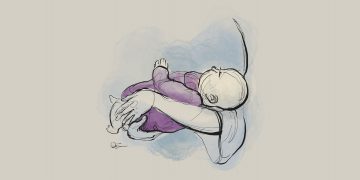(Read Part 1 here)
There are two main views on this topic and they are largely delineated by time period. Contemporary/modern theologians tend to take the view that the cross represents a rupture of the Trinity while classical theologians take the view that the Trinity always remained intact. While nuanced and dissenting views do exist, these are the two predominant views of each period.
Scholarship on this topic has increased in recent years with a renewed interest in discovering the true nature of Christ’s sacrifice. The result of this is that more contemporary scholars are championing the cause of a broken Trinity. Let’s take a closer look at the contemporary view.
Part 2: Contemporary View
At the head of this renewed interest in the theology of the cross is Jürgen Moltmann. As a prisoner of war, he was driven towards this view because it brought comfort and hope. “A theology which did not speak of God in the sight of the one who was abandoned and crucified would have had nothing to say to us then” (Moltmann, The Crucified God, 1). Therefore the heart of all theology is boiled down to the theology of the cross, “either Jesus who was abandoned by God is the end of all theology or He is the beginning of a specifically Christian, and therefore critical and liberating theology and life” (Moltmann, The Crucified God, 4).
In other words what differentiates Christian theology from all other worldviews is the theology of the suffering God, and at the heart of that very suffering is our understanding of His abandonment by the Father. The abandonment of Jesus, he argues, was an event that took place between God and God, an “enmity to the utmost degree.” Jesus literally becomes sin and is cursed by the Father at the point of the cross, which is what leads to His painful cry of abandonment.
But enmity wasn’t the only consequence of Jesus’ atonement, the very nature of the Father-Son relationship was broken. For in the forsaking of the Son the Father also forsook Himself. “The Fatherlessness of the Son is matched by the Sonlessness of the Father, and if God had constituted himself as the Father of Jesus Christ, then he also suffers the death of his Fatherhood in the death of his Son” (Moltmann, The Crucified God, 254).
For in the forsaking of the Son the Father also forsook Himself. “The Fatherlessness of the Son is matched by the Sonlessness of the Father, and if God had constituted himself as the Father of Jesus Christ, then he also suffers the death of his Fatherhood in the death of his Son” (Moltmann, The Crucified God, 254).
The social model of the Trinity defines each person of the Trinity by their relation to the other persons. The Father would not be the Father without the Son and vice-versa. The Spirit would not be the Spirit without proceeding from the Father through the Son. In short, each person of the Trinity exists in relation to the other persons. Thus in forsaking the Son, the Father forsook His very nature of being the Father.
The passion of Christ, according to Moltmann, is the complete rejection of the Son by the Father, the utter breaking of their relationship and the fracturing of the Godhead. This should not be mistaken as anything less, because only when we see the devastation of the Trinity do we see that the good news is actually good news – because this was the cost of our sin. “The Godness of the Father who gave up his only Son; the Godness of the Son who gave himself away; the Godness of the Spirit who, it seems, allowed death to sever the divine fellowship’s eternal bonds of unity” (Lewis, Between Cross and Resurrection, 324).
The passion of Christ, according to Moltmann, is the complete rejection of the Son by the Father, the utter breaking of their relationship and the fracturing of the Godhead. This should not be mistaken as anything less, because only when we see the devastation of the Trinity do we see that the good news is actually good news – because this was the cost of our sin.
Some contemporary Biblical scholars on the other hand don’t go as far as Moltmann in saying that the Trinity was severed, but most do recognize that something happened to the relationship between the Father and Son. In R.T. France’s commentary on Mark, he says that Mark creates a “mind-stretching antinomy, which Mark leaves unresolved for his readers to work at” (France, The Gospel of Mark, 653).
It is important to remember that Mark and Matthew wrote for a particular audience in mind. While that by no means gives us the right to dismiss difficult passages such as this one, it is important to understand that Mark was trying to do something with the text. “The ancient audiences would be experiencing Mark’s version of these events told in such a way as to have a particular impact on them and to result in changed attitudes and actions” (Rhoads, Mark as Story, 5).
Jesus crying, “my God why have you forsaken me” was probably inserted to show the immense suffering Jesus went through on the cross. Whether Mark and Matthew introduce that detail to make a theological point about the Godhead is something we need to hold in uncertain tension. D.A. Carson acknowledges that tension saying that “we hover at the edge of the mystery of the Trinity” (Carson, Scandalous, 33) when we try to understand His abandonment.
In summary, contemporary scholarship can be subdivided into two groups, one which exercises restraint by maintaining the mystery of the cross in acknowledging the original intent of the authors; and the other spearheaded by Jürgen Moltmann affirming a broken Trinity in order to demonstrate the gravity of the cross. Both however would affirm some sort of relational fissure between the Father and Son that came as a result of Christ “becoming sin” (2 Cor. 5:21 NIV).
In summary, contemporary scholarship can be subdivided into two groups, one which exercises restraint by maintaining the mystery of the cross in acknowledging the original intent of the authors; and the other spearheaded by Jürgen Moltmann affirming a broken Trinity in order to demonstrate the gravity of the cross.
In Part 3, we will look at the “classical view”.































































